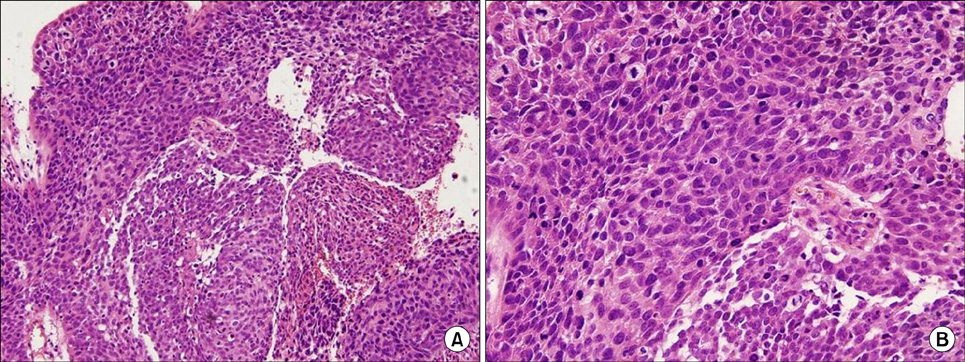J Gynecol Oncol.
2009 Sep;20(3):187-191. 10.3802/jgo.2009.20.3.187.
A case of neutrophilia related to a cytokine-producing relapsed squamous cell carcinoma of the uterine cervix arising from the rectovaginal septum
- Affiliations
-
- 1Department of Laboratory Medicine, Chosun University School of Medicine, Gwangju, Korea.
- 2Department of Obstetrics and Gynecology, Chosun University School of Medicine, Gwangju, Korea. sjhan@chosun.ac.kr
- KMID: 2173453
- DOI: http://doi.org/10.3802/jgo.2009.20.3.187
Abstract
- Paraneoplastic neutrophilia caused by a squamous cell carcinoma of the uterine cervix has been seen rarely. We report a case of relapsed squamous cell carcinoma of the uterine cervix with severe neutrophilia, rapid tumor growth and aggressive clinical course, possibly due to autocrine stimulation of cell growth by G-CSF and IL-6 without other possible causes of neutrophilia.
MeSH Terms
Figure
Reference
-
1. Agarwala SS. Paraneoplastic syndromes. Med Clin North Am. 1996. 80:173–184.2. Ferlito A, Elsheikh MN, Manni JJ, Rinaldo A. Paraneoplastic syndromes in patients with primary head and neck cancer. Eur Arch Otorhinolaryngol. 2007. 264:211–222.3. Hocking W, Goodman J, Golde D. Granulocytosis associated with tumor cell production of colony-stimulating activity. Blood. 1983. 61:600–603.4. Kyo S, Kanaya T, Takakura M, Inoue M. A case of cervical cancer with aggressive tumor growth: possible autocrine growth stimulation by G-CSF and Il-6. Gynecol Oncol. 2000. 78:383–387.5. Ahn HJ, Park YH, Chang YH, Park SH, Kim MS, Ryoo BY, et al. A case of uterine cervical cancer presenting with granulocytosis. Korean J Intern Med. 2005. 20:247–250.6. Halkes CJ, Dijstelbloem HM, Eelkman Rooda SJ, Kramer MH. Extreme leukocytosis: not always leukaemia. Neth J Med. 2007. 65:248–251.7. Kaushansky K. Lineage-specific hematopoietic growth factors. N Engl J Med. 2006. 354:2034–2045.8. Banks RE, Forbes MA, Storr M, Higginson J, Thompson D, Raynes J, et al. The acute phase protein response in patients receiving subcutaneous IL-6. Clin Exp Immunol. 1995. 102:217–223.9. Karnath BM, Luh JY, Suleman K, Rouan GW. Urethelial carcinoma mimicking as chronic myelogenous leukemia. Adv Stud Med. 2006. 6:331–332.10. Symonds RP, Collingwood M, Kirwan J, Humber CE, Tierney JF, Green JA, et al. Concomitant hydroxyurea plus radiotherapy versus radiotherapy for carcinoma of the uterine cervix: a systematic review. Cancer Treat Rev. 2004. 30:405–414.
- Full Text Links
- Actions
-
Cited
- CITED
-
- Close
- Share
- Similar articles
-
- Verrucous Carcinoma of Uterine Cervix: A case report
- Sarcomatoid squamous cell carcinoma of uterine cervix
- A Case of Ovarian Squamous Cell Carcinoma in a Patient with Microinvasive Squamous Cell Carcinoma of Cervix
- Lectins Binding in Squamous Cell Carcinoma of the Uterine Cervix as a Diagnostic and Prognostic Marker
- Adenoid Basal Carcinoma Associated with Invasive Squamous Cell Carcinoma of Uterine Cervix: A case report





